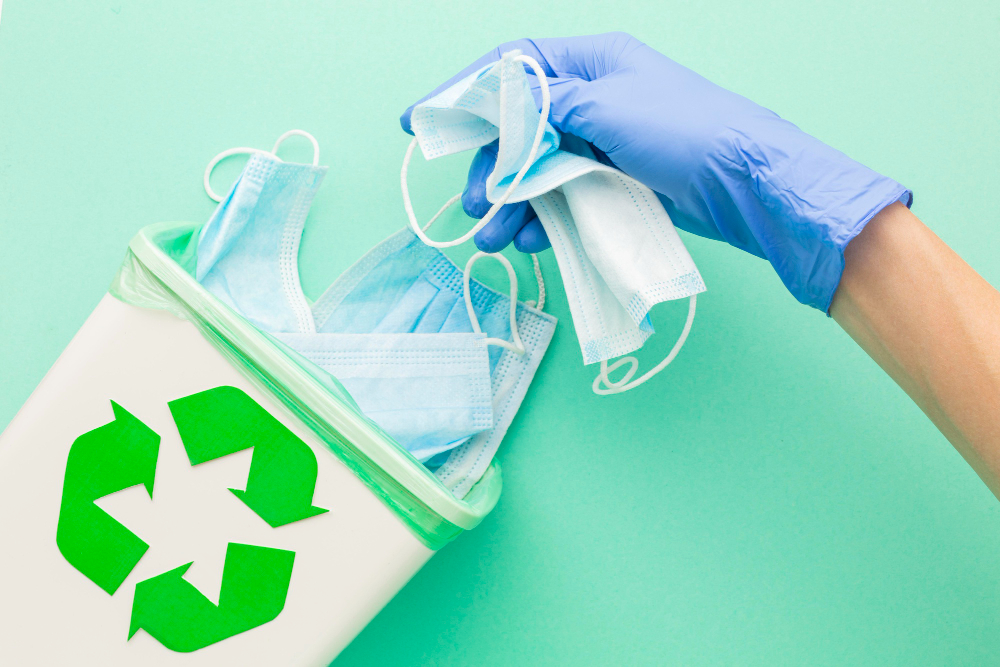How Mask Recycling Programs Are Quietly Reshaping Environmental Responsibility

When the world faced the COVID-19 pandemic, single-use face masks became a daily necessity. But the surge in disposable PPE waste brought a new environmental challenge — plastic pollution. Millions of masks ended up in landfills, oceans, and city streets. Today, mask recycling programs are quietly changing how society handles this waste. These initiatives are helping reshape what environmental responsibility means in a post-pandemic world.
The idea is simple: instead of letting used masks pile up, recycling them turns the waste into something useful. From building materials to textiles, the potential uses are growing fast. The transformation is not loud or flashy, but it’s real — and it’s reshaping our environmental habits in ways few expected.
The Rising Problem of Mask Waste
How COVID-19 Accelerated PPE Pollution
During the pandemic, billions of people used disposable surgical masks and N95 respirators daily. Each mask contains layers of polypropylene, a type of plastic that takes decades to break down. According to environmental studies, over 1.6 billion masks entered the ocean in 2020 alone. This sudden spike in waste created a new global pollution crisis. The masks protected humans, but they harmed ecosystems.
The Environmental Toll of Single-Use Masks
Discarded masks don’t just vanish. When they degrade, they release microplastics into the air, soil, and water. Marine animals often mistake mask fibers for food, leading to health issues or death. Even landfills are struggling with the volume of PPE waste. The result is a growing environmental footprint that threatens wildlife and public health.
Microplastic Contamination from Disposed Masks
Microplastics from masks are now found in rivers, beaches, and even human bodies. Researchers have discovered tiny fibers from nonwoven fabric layers in ocean sediments and drinking water. These particles enter the food chain, affecting everything from plankton to people. The problem isn’t just visible pollution — it’s a silent contamination spreading worldwide.
Innovative Solutions for Mask Recycling
Emerging Technologies Turning Masks into Raw Material
Modern recycling methods are changing the game. Thermal processing, mechanical shredding, and chemical recycling can break down mask components into reusable polymers. These methods transform PPE waste into granules that can be used in 3D printing, road construction, or plastic manufacturing. Scientists are even exploring biodegradable mask materials to simplify future recycling.
Community-Level Mask Recycling Programs
Some regions have launched small-scale programs encouraging people to drop off used masks at designated points. Local initiatives often combine education campaigns with accessible collection bins, helping communities understand the impact of PPE waste. These programs build a sense of shared responsibility and connect citizens to real-world environmental action.
The Role of Research and Public Policy
Governments and researchers are stepping in to improve recycling infrastructure. Studies from environmental agencies are guiding policy changes to make PPE waste management more efficient. By setting new standards and funding eco-innovation, policymakers can help make mask recycling a permanent part of the sustainability agenda.
Why Mask Recycling Matters
Breaking Down the Components of a Disposable Mask
A typical disposable mask includes polypropylene layers, elastic ear loops, and metal nose clips. Each material requires a different approach to recycle safely. Advanced sorting and sterilization processes separate the components before reprocessing. Once cleaned, they can be turned into raw materials for various applications, like pellets for manufacturing or fibers for textiles.
How Recycling Helps Reduce Landfill Burden
Every recycled mask reduces the strain on landfills and lowers the overall carbon footprint. By turning waste into resources, recycling prevents long-term environmental damage. The process also reduces the need for virgin plastic production, which means less oil extraction and fewer greenhouse gas emissions. It’s a practical step toward a sustainable waste management system.
Environmental and Economic Benefits of Mask Repurposing
Mask recycling isn’t just an environmental win — it’s an economic opportunity. Recycled materials can be used to make construction products, insulation boards, and reusable fabrics. These recycled goods often cost less and require fewer resources to produce. Over time, they can help create green jobs and promote a circular economy, where waste becomes the starting point for new materials.
Real Challenges in Recycling Masks
Complex Material Composition and Sorting Difficulties
One of the biggest challenges in mask recycling is material complexity. Masks contain mixed elements — plastics, metals, and fabrics — bonded together. Separating these layers without damaging them requires specialized technology. Many recycling centers lack the equipment or expertise to handle PPE waste safely.
Lack of Collection Systems and Awareness
Even if the technology exists, collection remains a problem. Many people don’t know where or how to recycle masks. Without clear collection bins or public programs, masks often end up in regular trash. This lack of awareness limits participation and reduces recycling efficiency.
High Cost of Decontamination Processes
Before recycling, masks must be thoroughly disinfected to remove any biological contaminants. The decontamination process adds cost, energy use, and time. For many local waste management systems, the expenses outweigh the benefits — making large-scale recycling difficult. However, newer low-cost sterilization methods are emerging, promising to make this step more affordable.
Future of Sustainable PPE
Designing Masks for a Circular Economy
To make recycling easier, mask manufacturers are exploring eco-friendly materials like bioplastics and plant-based polymers. The goal is to design masks that can be fully recycled or composted. This approach supports a circular economy, where products are designed for reuse from the start.
Policy Support for Medical Waste Recycling
Strong policies can encourage healthcare systems and businesses to adopt mask recycling. Governments can offer incentives, tax breaks, or grants for recycling programs. They can also regulate PPE waste to ensure proper disposal and promote cleaner production. The combination of public policy and private innovation can create long-term sustainability.
How Consumers Can Participate in Mask Recycling
Ordinary people play a huge role in this transformation. By learning where to recycle masks or switching to reusable cloth options, consumers help reduce waste. Supporting recycling programs and spreading awareness in communities makes environmental responsibility a shared mission — not just a government task.
Conclusion
Mask recycling programs may not dominate headlines, but they are quietly shaping a new kind of environmental awareness. They remind us that even small actions — like recycling a single mask — can make a difference. From advanced recycling technologies to community drop-off stations, these programs are turning waste into a lesson in responsibility.
As the world moves forward, the goal isn’t just to reduce waste — it’s to rethink how we value materials. The journey of a mask from trash to resource shows that environmental responsibility isn’t about perfection. It’s about progress — one recycled mask at a time.



